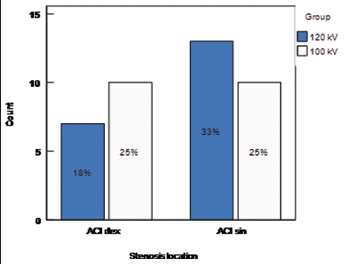Benefits of low-dose carotid CT angiography in stroke patients
DOI:
https://doi.org/10.17532/jhsci.2023.2357Keywords:
Computed Tomography Angiography, Contrast Media, Signal-To-Noise Ratio, Radiation, IonizingAbstract
Introduction: Computed tomography angiography (CTA) represents the gold standard as a method for the diagnosis of carotid artery diseases. The current topic is the use of CTA for the evaluation of carotid arteries with a reduction in the dose of contrast agent and dose of ionizing radiation, which, with adequate preparation, would enable the use of this method in some risk groups. The aim of this study was to evaluate the feasibility and image quality of a new low-dose CTA protocol in comparison with a standard protocol.
Methods: Forty patients with recumbent ischemic stroke were included in the study, twenty of whom underwent lowdose CTA, and the remaining twenty underwent a standard CTA protocol of the carotid arteries.
Results: No significant difference was found between the mean values of CT number (Hounsfield unit), signal-to-noise ratio, contrast-to-noise ratio, and subjective assessment of image quality in the comparison of the control and experimental groups. CT dose index, volume, and dose length product were significantly lower in patients who underwent lowdose carotid CTA. There was no significant difference in the degree of carotid stenosis between color Doppler and CTA.
Conclusion: The use of the low-dose protocol for carotid CTA allows the application of this method in risk groups, in which it was previously not possible to perform, with the same image quality in comparison with the standard protocol.
Downloads

Downloads
Published
License
Copyright (c) 2023 Haris Kurić, Spomenka Kristić, Jasna Strika-Kurić, Sandra Vegar-Zubović, Adnan Beganović, Merim Jusufbegović, Fuad Julardžija, Adnan Šehić

This work is licensed under a Creative Commons Attribution 4.0 International License.










